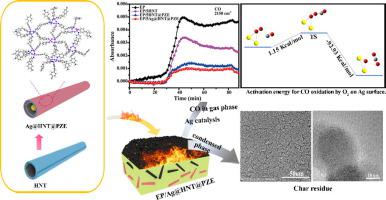Chemical Engineering Journal ( IF 15.1 ) Pub Date : 2020-09-24 , DOI: 10.1016/j.cej.2020.127087 Jing Hong , Tong Wu , Haiyang Wu , Birong Zeng , Shanni Zeng , Ting Chen , Xiu Wang , Zhenwu Lu , Conghui Yuan , Krishnasamy Balaji , Denise F.S. Petri , Lizong Dai

|
In an attempt to develop an efficient flame retardant for epoxy resin (EP), a hierarchical “dots-core–shell” structure Ag@HNT@PZE was prepared via simple two-step reactions including in-situ growth of Ag within halloysite nanotubes (HNT) and a crosslinking polymerization of polyphosphazene (PZE) coating on Ag@HNT surfaces. Wherein, the dots represented Ag nanoparticles, the core represented HNT, and the shell referred to PZE. Here, Ag encapsulated within HNT acts as an interfacial catalyst to effectively degrade toxicity gas (e.g. CO), while PZE acts as an interfacial compatibilizer for enhancing the dispersion and flame retardant efficiency of Ag@HNT@PZE in the matrix. The flammability and smoke toxicity of EP/Ag@HNT@PZE nanocomposites were both reduced greatly compared to neat EP. The limited oxygen index (LOI), UL-94 grade and char yield of composite EP/5Ag@HNT@PZE reached 33.6 ± 0.72%, V-0 level and 22.8% respectively. Moreover, the peak heat release rate (pHRR) was reduced by 34.2%, accompanied by a higher ratio of graphitized char layer. It showed that flammable pyrolysis products released from EP during combustion were distinctly inhibited because Ag nanoparticles could catalyze the conversion of flammable gas CO to nonflammable CO2, which were verified by the density functional theory (DFT) calculations. It was assumed that halloysite-based hybrid flame retardant could have an impact on toxicity-suppressing and catalyze char formation to produce a barrier effect. The combination of metal-immobilized at clay nanotubes interiors for agglomeration-tolerant and PZE-modified at clay nanotubes exterior for shell-protective provides a potential way to develop efficient flame retardant for the manufacture of nanocomposites with higher fire safety.
中文翻译:

聚磷腈包覆的纳米杂化银纳米颗粒@硅藻土纳米管可有效增强环氧树脂的防火性能
为了开发一种有效的环氧树脂(EP)阻燃剂,通过简单的两步反应(包括在埃洛石纳米管中原位生长Ag)制备了分层的“点-核-壳”结构Ag @ HNT @ PZE( HNT)和Ag @ HNT表面上的聚磷腈(PZE)涂层的交联聚合。其中,点表示Ag纳米颗粒,核表示HNT,壳表示PZE。在此,封装在HNT中的Ag充当界面催化剂,以有效降解有毒气体(例如CO),而PZE充当界面相容剂,以增强Ag @ HNT @ PZE在基体中的分散和阻燃效率。与纯EP相比,EP / Ag @ HNT @ PZE纳米复合材料的可燃性和烟雾毒性均大大降低。极限氧指数(LOI),复合材料EP / 5Ag @ HNT @ PZE的UL-94级和炭收率分别达到33.6±0.72%,V-0级和22.8%。此外,峰值放热率(pHRR)降低了34.2%,同时石墨化炭层的比例更高。结果表明,在燃烧过程中从EP释放的可燃热解产物受到明显抑制,因为Ag纳米颗粒可以催化可燃气体CO转化为不可燃CO。如图2所示,它们通过密度泛函理论(DFT)计算得到了验证。假定基于埃洛石的混合阻燃剂可能对抑制毒性和催化焦炭生成产生屏障作用产生影响。固定在粘土纳米管内部用于结块的金属固定和在粘土纳米管外部用于壳保护的PZE改性的组合提供了开发高效阻燃剂的潜在途径,该阻燃剂用于制造具有更高防火安全性的纳米复合材料。


























 京公网安备 11010802027423号
京公网安备 11010802027423号